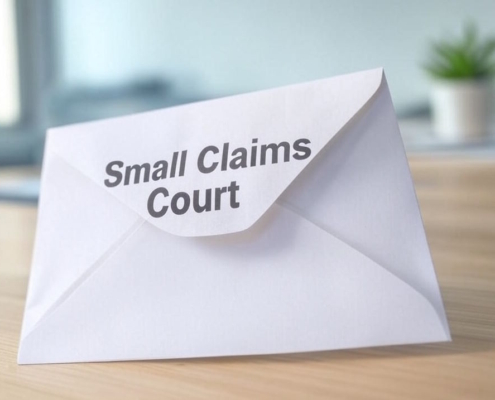How Does a Demand Letter Work?
Nobody wants the trouble of a lawsuit when there is an alternative way to resolve an issue. That’s why a demand letter is usually sent as the first step in resolving a dispute. By outlining your position, the costs you’ve incurred, and the amount you’re requesting in settlement, the demand letter initiates communication between you and the other party. After sending a demand letter in an attempt to resolve the dispute, if that fails as well, you have the option to submit a small claims court claim.
Even in low-stakes cases, demand letters play an important role in the judicial process and the settlement of disputes. Demand letters, whether for debt collection or to settle claims for property damage or a contract breach, lay out the problems that need fixing and, when written properly, pave the way for settlement talks.
Advantages of a Demand Letter
Prior to submitting a lawsuit, many courts ask litigants to attempt to resolve the matter through settlement. A demand letter is an ideal medium for this since, in addition to fulfilling the legal obligation, the letter itself offers additional advantages.
1. Helps Bring Cases to a Close
If you demand payment in a clear and succinct letter, you may avoid the hassle of a small claims case. Writing out the reasons your opponent owes you money demonstrates action, even if you have already tried and failed to argue with them over the phone or in person.
Now that your opponent is aware of your seriousness, they will have no choice but to confront you. Fighting a lawsuit requires effort and time, but there’s a chance you could come out on top. To sum up, putting your argument in writing will improve your chances of receiving payment.
2. Assists in Case Organization
The “claim” form initiates a small claims court case, but there’s more to it than that. You’ll be pleased you took the time to consider all of your options before writing your demand letter. Also, you need to be able to articulate your case to a judge and back it up with proof.
Putting your argument into writing is what a demand letter is all about. Giving evidence and citing the relevant statutes will help you explain what transpired. Along with explaining why you’ll win, you’ll detail the evidence that supports your case, which may include invoices and photos. If you ever have to go to court, you’ll be more prepared to deal with a similar process.
So, a demand letter may not be required by law, but it could still help you get a settlement. And if that doesn’t work, you can always write up an official letter outlining your stance and use it as a foundation for your court case.
3. Negotiations for an Informal Settlement
A good first step is to try to work out the issue amicably via phone, email, or even in person if the parties are amicable. Get your recovery goals or the desired course of action in mind and come up with a strategy for negotiation before reaching out.
To determine your out-of-pocket expenses and the amount you want your opponent to pay, you will review contracts, invoices, and other relevant documents. If you want to avoid taking less than you deserve, these calculations will tell you when to walk away.
It will also keep you from asking for more in the future in the event that the first negotiation fails. When the amount demanded increases, it’s normal for people to get angry.
When Is a Demand Letter Necessary?
Send a demand letter after informal settlement efforts have failed. You can lay out your history of dealings, make a formal offer to settle the dispute, and stress your intention to take legal action (i.e., file a lawsuit) if the demand isn’t satisfied.
You have the option to send the demand letter prior to submitting an action, skipping over informal settlement talks. The letter will serve as proof that you formally demanded payment prior to submitting your lawsuit, which is a requirement of many courts.
Parts of a Demand Letter
Every demand letter needs to have specific components, so it’s important to know what those are. Here is a brief outline of the items you should address:
- Case details: A summary of the events that took place.
- Problem description: Provide a concise overview of the issue.
- Demand: The sum or course of action required to settle the matter.
- Deadline to respond: The deadline for receiving a response.
- Consequences of noncompliance: A potential outcome in the event that the demand is not satisfied.
For those who want to delve further into the why, how, and what of demand letters, we’ve included some additional information about the basics below.
1. Show Politeness
You should avoid attacking your opponent on a personal level, even if you think that it is warranted, because doing so encourages the other party to respond in a similar manner themselves. When arguing a point in court or any other situation, it is important to remain composed and confident. This will make you more convincing.
2. Provide the Details
Outlining these details might appear strange at first. Your opponent is aware of the backstory, after all. However, this does not necessarily hold true in all instances. It is your responsibility to guarantee that they recall all of the facts, as many people tend to recall only those facts that support their own position.
Also, a judge might read the letter if you wind up in court, and they should have the opportunity to understand what happened. Basically, it’s a quick and easy way to document the argument and everything that happened after it, like the defendant’s inappropriate behavior, ignored calls, and subsequent phone conversations.
3. Defend Your Losses
You’ll detail the real losses you endured, including things like doctor’s visits, lost wages, property damage, and repair bills. Be sure to keep all relevant documents, such as invoices, receipts, and repair estimations, after removing any sensitive information, like credit card numbers. Having images of the damage is also beneficial.
4. Get What You Want by Asking for More
In business deals involving sophisticated negotiators, it is wise to ask for more than what is actually due in order to account for things like punitive damages, pain and suffering, or “blue sky” (immaterial damages). If you’re hoping to reach a settlement of $20,000, for example, you probably won’t start with that amount since it leaves little space for negotiation.
You’re going to want more. Negotiations are likely to come to a standstill unless you do this. Why? Reason being, experienced negotiators, such as lawyers and businesspeople, will likely assume that you have given them some wiggle room and will push you to lower your first request. If needed, review common approaches to negotiation.
5. Decide on a Timeframe
Dealing with insurance agents or anyone else without the power to resolve the issue usually requires at least two weeks, but one week can make things seem urgent. Putting off dealing with you until later won’t get you anywhere. Give a specific date to clarify the deadline. At the end, be sure to mention that you will seek legal action if the recipient does not pay your demand.
6. Create and Save Duplicates
Before sending any letters through certified mail (with a return receipt requested), be sure to print out the relevant receipts from the post office. Avoid erasing it if you send it via email. Save all communication from your opponent.
How and When to Send Certified Mail
It is acceptable to communicate by email since many people and companies use it nearly exclusively. (But a handwritten letter can leave a deeper impact, even though email is fast and widely used.) Try sending a certified letter with a return receipt requested if your email demand letter goes unanswered. Small claims court is a good place to utilize return receipts to disprove the opponent’s claim that they didn’t get the demand letter.
Getting ready to draft the demand letter
If you feel that stating facts isn’t enough to write a convincing letter, you’d be right. Simply put, being diplomatic is key, whether you’re drafting a demand letter or arguing your case in court.
1. Set the mood
Try to imagine what it’s like to be the receiver to help you strike the correct tone. How would the letter make you feel? You can make your demand more convincing by thinking about the recipient’s reaction.
Keep in mind that it’s easier to get someone to agree if they see an upside or opt to resolve the case. Although they can be useful, threats of negative consequences or possible punishment are less successful. Try to frame your letter in a way that makes the receiver think settling is the best course of action.
2. Stay focused on your objective
Your aim is not to enrage the receiver; rather, you wish for the other party to resolve the matter. Rather than appealing to their emotions, try to get them to think about the situation rationally.
It is your goal for the letter to prompt the “defendant,” or the entity you are suing, to consider the following:
- The time it takes to mount a defense
- The publicity of a dispute
- The odds of losing
- The cost of losing
- Settlement as a cheaper option
Make sure to craft the letter in a manner that prompts your opponent to consider the issues at hand, rather than directly stating your questions.
Avoiding Common Errors
Compared to handwritten letters, typed ones appear more polished and professional. Making the journey to the library is a good idea if you do not have access to a computer. Additional points to bear in mind:
- Keep your cool and do not act irrationally. Retain your impartiality and professionalism.
- Leave out any extraneous information. Be sure to address the issue at hand and provide any necessary proof to back up your claim.
- Recall the need to comply with regulations. Keep yourself apprised of any applicable legal standards.
- Think about the receiver’s reaction and how receptive they are to the request once you’ve finished. The aim is to make the person think about the situation, evaluate their role, and decide that the best choice is to reach an agreement.
Making Sure Your Demand Letter Is Perfect
Keep in mind that no one ever gets a perfect first draft, so it’s normal if yours falls short of your expectations. Putting pen to paper and returning to it with a new perspective first thing in the morning will always yield better results. Make sure you have included all the necessary elements to create a forceful and convincing demand letter before sending it.
- Keep an approachable, impartial tone.
- Clearly state the facts.
- Outline the expenses or “damages” that you have experienced.
- Clearly state your entire request.
- Request more than what you actually want to give yourself room to negotiate.
- Set a due date for the response.
- Outline your plan B in the event that the demand isn’t satisfied.
Make as many edits as necessary to the letter until you are satisfied with its flow and expression.
Sending the Demand Letter
You can choose to send it by certified mail, email, or deliver it in person. Regardless of the approach you choose, be sure to retain a duplicate for your files and record every exchange for reference purposes.
Leave enough time for the receiver to respond after you send the demand letter. As soon as you get it, check to see if the answer is satisfactory. On the other hand, you might want to think about responding. Resolving a disagreement usually requires patience, energy, and multiple conversations.
If you do not hear back by the due date, you should move forward with your plan, which may include proposing mediation or starting legal procedures.
Demand Letter Samples
Here are letters a customer might send to a car repair shop after bad repair work and to a contractor who messed up a renovation.
1. Letter for Auto Repair
August 10, 2024
Smith’s Garage
1000 Main Street
Los Angeles, CA
Dear Mr. Smith,
I had my vehicle serviced at your facility on June 7, 2024. The engine caught fire shortly after its pickup the following day. Thankfully, I managed to put out the fire without suffering any harm.
Due to the engine fire, I had to pay the XYZ garage $1,500 for the necessary repairs. According to XYZ Garage, the fire was caused by your improperly connecting the fuel line to the fuel injector. I have included a duplicate of their bill. Additionally, I had to get a rental car to get to work because I was without my own car for three days. The $145 rental fee is detailed on the attached invoice.
You recently asserted over the phone that the fire was inevitable and not caused by your carelessness. You even implied that I should have returned my vehicle to your shop for a discounted repair, regardless of whether it had been your fault.
First, the fuel injector—the very component of the vehicle you were repairing—was the source of the fire, according to Sam Williams of XYZ Garage, who is willing to testify in court. Secondly, it was not my responsibility to send the car back to you for additional repairs. I am ready to show you multiple higher estimates from other garages as proof that the problem you caused was fixed at a reasonable price.
You have until July 15 to send me $1,426 in the form of a money order or check. I will sue you in small claims court without delay if you do not pay me by the specified date. I will pursue all available legal options in order to collect the money judgment. It will also be accessible to credit bureaus as public record.
Contact me at 555-555-5555 during the day or 555-555-6666 until 9 p.m.
Best regards,
Cara Griffith
2. Home Improvement Letter
May 20, 2024
Superstar Construction
123 Sunshine Avenue
San Diego, CA
To Whom It May Concern,
During the renovation of my upstairs bathroom at 456 Juniper Street, you installed new tiles. According to our agreement from April 23, 2024, I paid you $3,000 to perform the job.
Two weeks after you finished the job, on May 7, the south portion of the shower’s tile had sunk nearly an inch, revealing that there were issues with your work. The uneven surface of the shower floor causes water to pool in one corner and drain slowly.
I didn’t like how you implied during our phone conversation that the problem was small or that it was all in my head.
You have refused to fix the problem, and I had to pay another contractor to repair the shower because you did not do a competent job remodeling my bathroom. Now I am requesting that you pay for their services.
Enclosed is ABC Tile’s estimate for $1,500 to fix the shower floor. Within ten days, please send $1,200. I am prepared to sue in small claims court if I do not receive the money by June 1, 2024.
Best regards,
Will Thomas































